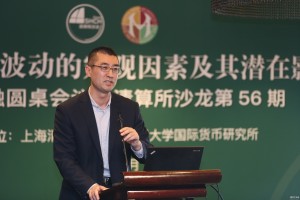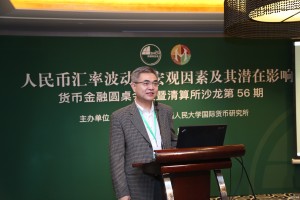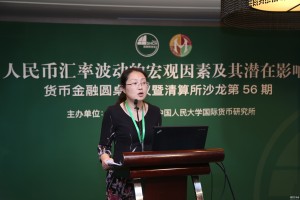Roundtable on Money and Finance and the 56th Clearing House Salon: Macro Factors of the RMB Exchange Rate Fluctuation and its Potential Effect
2017-04-15 IMI Wei Benhua and Chen Guang have made wonderful opening remarks. Wei thinks that the RMB exchange rate will not experience long-term devaluation. The two-way fluctuation of the RMB exchange rate is very normal. The RMB exchange rate needs to be analyzed based on the long-term trend and we should not struggle with short-term fluctuations.
Wei Benhua and Chen Guang have made wonderful opening remarks. Wei thinks that the RMB exchange rate will not experience long-term devaluation. The two-way fluctuation of the RMB exchange rate is very normal. The RMB exchange rate needs to be analyzed based on the long-term trend and we should not struggle with short-term fluctuations.
 Chen Guang holds that China's exchange rate system serves our overall development strategy, in line with China's development requirements. In the next stage, the RMB exchange rate system will be better adapted to the requirements of China's market-oriented economic reform. Moreover, it is an important job of Shanghai Clearing House to maintain the sound and stable development of the RMB derivative market.
Chen Guang holds that China's exchange rate system serves our overall development strategy, in line with China's development requirements. In the next stage, the RMB exchange rate system will be better adapted to the requirements of China's market-oriented economic reform. Moreover, it is an important job of Shanghai Clearing House to maintain the sound and stable development of the RMB derivative market.
 Sun Lujun’s speech centers around the “variety” and “stability” of the RMB exchange rate. He first analyzes the new domestic economic and financial problems and structural problems in the balance of payments in order to explain why the statement that “there is no basis for a sustained depreciation trend for the RMB” does not agree with the fact that RMB continues devaluating after the “8/11 Exchange Rate Reform”. He thinks that the RMB is fundamentally overvalued. Then, he analyzes the new changes of the RMB exchange rate since the beginning of 2017 through detailed data, such as a narrow trading band, the reversal of the spread between CNH and CNY, the devaluation of RMB against a basket of currencies, the tightening of the liquidity of the offshore RMB market in Hong Kong, and so on. The “stability” mainly refers to the fact that investment remains the main driving force of domestic economic growth. Although the capital outflow shows some signs of improvement, it is still difficult to reverse in the short term. Finally, he makes an analysis of the impact of Sino-US relations on the RMB exchange rate. He believes that the Sino-US trade war is unlikely to occur and the dollar interest rate is not equal to the appreciation of the dollar. He indicates that the RMB still has room for depreciation but the range will be narrower than before.
Sun Lujun’s speech centers around the “variety” and “stability” of the RMB exchange rate. He first analyzes the new domestic economic and financial problems and structural problems in the balance of payments in order to explain why the statement that “there is no basis for a sustained depreciation trend for the RMB” does not agree with the fact that RMB continues devaluating after the “8/11 Exchange Rate Reform”. He thinks that the RMB is fundamentally overvalued. Then, he analyzes the new changes of the RMB exchange rate since the beginning of 2017 through detailed data, such as a narrow trading band, the reversal of the spread between CNH and CNY, the devaluation of RMB against a basket of currencies, the tightening of the liquidity of the offshore RMB market in Hong Kong, and so on. The “stability” mainly refers to the fact that investment remains the main driving force of domestic economic growth. Although the capital outflow shows some signs of improvement, it is still difficult to reverse in the short term. Finally, he makes an analysis of the impact of Sino-US relations on the RMB exchange rate. He believes that the Sino-US trade war is unlikely to occur and the dollar interest rate is not equal to the appreciation of the dollar. He indicates that the RMB still has room for depreciation but the range will be narrower than before.
 Professor Xiao Geng emphasizes the importance of a stable exchange rate. He points out that the trade surplus should not be considered as a yard stick in giving the statement that “there is no basis for a sustained depreciation trend for the RMB”. For China, the re-allocation of assets has brought itself the long-term devaluation pressure, and the trade surplus has no decisive impact on the RMB exchange rate. Since the “8/11 Exchange Rate Reform”, a series of capital controls that China has adopted are helpless but necessary. The exchange rate is not the price of the general commodity, but the link between the two price systems. Historical experience shows that only a stable exchange rate can promote financial openness. China urgently needs to develop the government bond market, form an effective yield curve of government bonds, improve the financial infrastructure and solve the “last kilometer” problem in the financial sector, thus creating favorable conditions for easing the capital control and stabilizing the RMB exchange rate.
Professor Xiao Geng emphasizes the importance of a stable exchange rate. He points out that the trade surplus should not be considered as a yard stick in giving the statement that “there is no basis for a sustained depreciation trend for the RMB”. For China, the re-allocation of assets has brought itself the long-term devaluation pressure, and the trade surplus has no decisive impact on the RMB exchange rate. Since the “8/11 Exchange Rate Reform”, a series of capital controls that China has adopted are helpless but necessary. The exchange rate is not the price of the general commodity, but the link between the two price systems. Historical experience shows that only a stable exchange rate can promote financial openness. China urgently needs to develop the government bond market, form an effective yield curve of government bonds, improve the financial infrastructure and solve the “last kilometer” problem in the financial sector, thus creating favorable conditions for easing the capital control and stabilizing the RMB exchange rate.
 Cheng Leilei talks about the development of China's exchange rate derivatives through the business scale, variety changes and other aspects. She points out that the development of exchange rate derivatives is based on a relatively loose foreign exchange trading environment and a larger range of exchange rate fluctuations. At the same time, she introduces the necessity and significance of the central counterparty clearing mechanism, which is one of the systemic financial risk management tools, and demonstrates the core content of this mechanism from four aspects: the member access mechanism, settlement guarantee mechanism, risk management system and the multilateral netting mechanism. Finally, she analyzes the current situation and future development of the exchange rate derivatives central counterparty clearing services launched by Shanghai Clearing House.
Cheng Leilei talks about the development of China's exchange rate derivatives through the business scale, variety changes and other aspects. She points out that the development of exchange rate derivatives is based on a relatively loose foreign exchange trading environment and a larger range of exchange rate fluctuations. At the same time, she introduces the necessity and significance of the central counterparty clearing mechanism, which is one of the systemic financial risk management tools, and demonstrates the core content of this mechanism from four aspects: the member access mechanism, settlement guarantee mechanism, risk management system and the multilateral netting mechanism. Finally, she analyzes the current situation and future development of the exchange rate derivatives central counterparty clearing services launched by Shanghai Clearing House.
 Liu Jun discusses the “multidimensional motivations of currency internationalization”. Liu Jun believes that the initial driving force of currency internationalization arises from the cross-border trade needs. The fundamental attribute of the currency lies in the national interest. The level of currency internationalization is the embodiment of national strength; in the process of forming the Bretton Woods system, the national interest is a reason why the United States wanted to enable the dollar to become a currency anchor. Through currency manipulation, the United States changed the result of the Suez Crisis between the Egypt and British and France, which also reflects the currency’s national properties. He then introduces the three paths of currency internationalization and points out the lack of vitality of the super-sovereign currency in reality. Taking the transfer of the euro clearing after Brexit as an example, he explores the difference between the central currency and the money center. He believes that not only China but also other countries support the RMB internationalization. China, as the second largest economy, has stepped into the international arena. China’s contribution to the global GDP growth is remarkable, and its national strength represented by RMB is being widely recognized around the world. Finally, Liu Jun analyzes in detail the difference between the exchange rate and the monetary value, and the difference between the use value and real value of the currency.
Liu Jun discusses the “multidimensional motivations of currency internationalization”. Liu Jun believes that the initial driving force of currency internationalization arises from the cross-border trade needs. The fundamental attribute of the currency lies in the national interest. The level of currency internationalization is the embodiment of national strength; in the process of forming the Bretton Woods system, the national interest is a reason why the United States wanted to enable the dollar to become a currency anchor. Through currency manipulation, the United States changed the result of the Suez Crisis between the Egypt and British and France, which also reflects the currency’s national properties. He then introduces the three paths of currency internationalization and points out the lack of vitality of the super-sovereign currency in reality. Taking the transfer of the euro clearing after Brexit as an example, he explores the difference between the central currency and the money center. He believes that not only China but also other countries support the RMB internationalization. China, as the second largest economy, has stepped into the international arena. China’s contribution to the global GDP growth is remarkable, and its national strength represented by RMB is being widely recognized around the world. Finally, Liu Jun analyzes in detail the difference between the exchange rate and the monetary value, and the difference between the use value and real value of the currency.
 During the roundtable discussion, Wang Yongli, Senior Vice President of LeTV, Di Dongsheng, Associate Professor of School of International Studies of RUC, Li Jing, Professor of School of Economics of Capital University of Economics and Business, and some representatives from Bank of China and Ping An Bank all share their own opinions on the RMB exchange rate.
During the roundtable discussion, Wang Yongli, Senior Vice President of LeTV, Di Dongsheng, Associate Professor of School of International Studies of RUC, Li Jing, Professor of School of Economics of Capital University of Economics and Business, and some representatives from Bank of China and Ping An Bank all share their own opinions on the RMB exchange rate.
